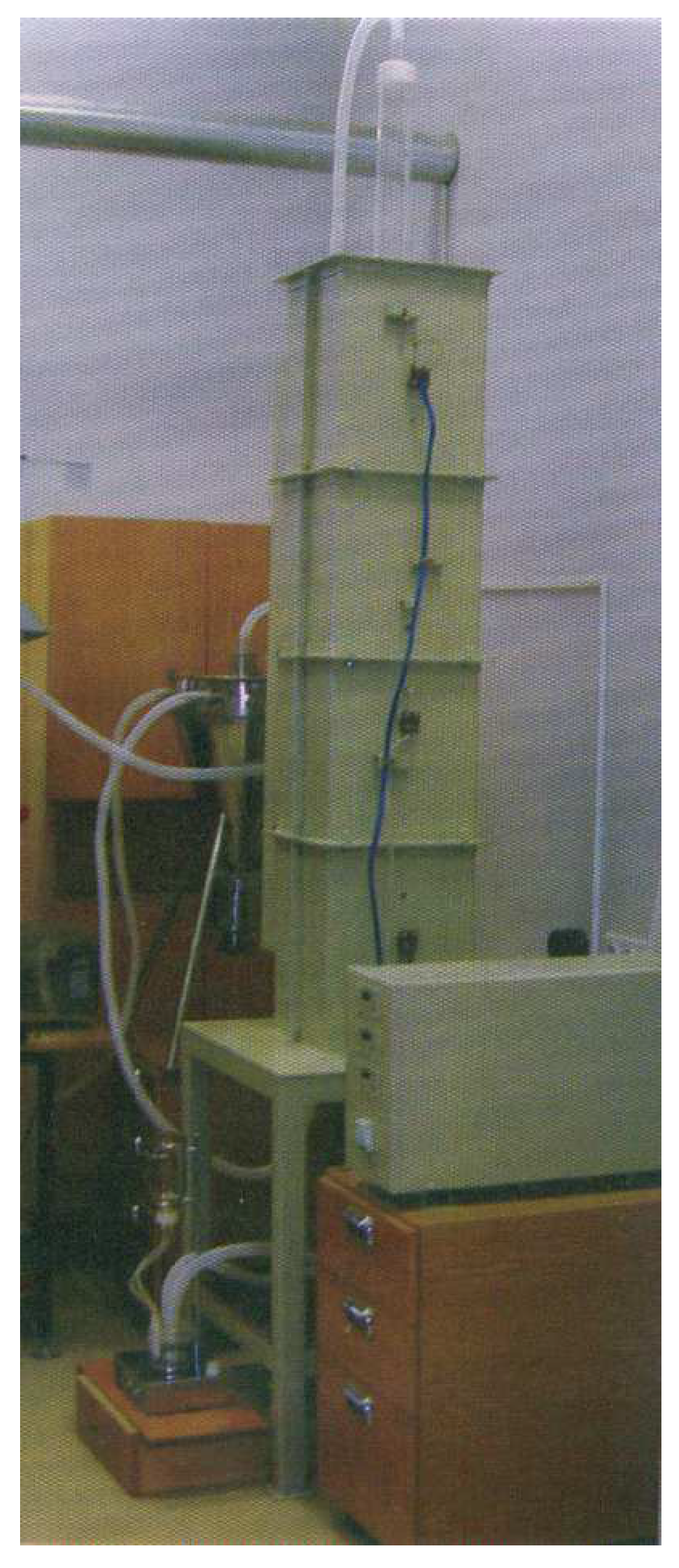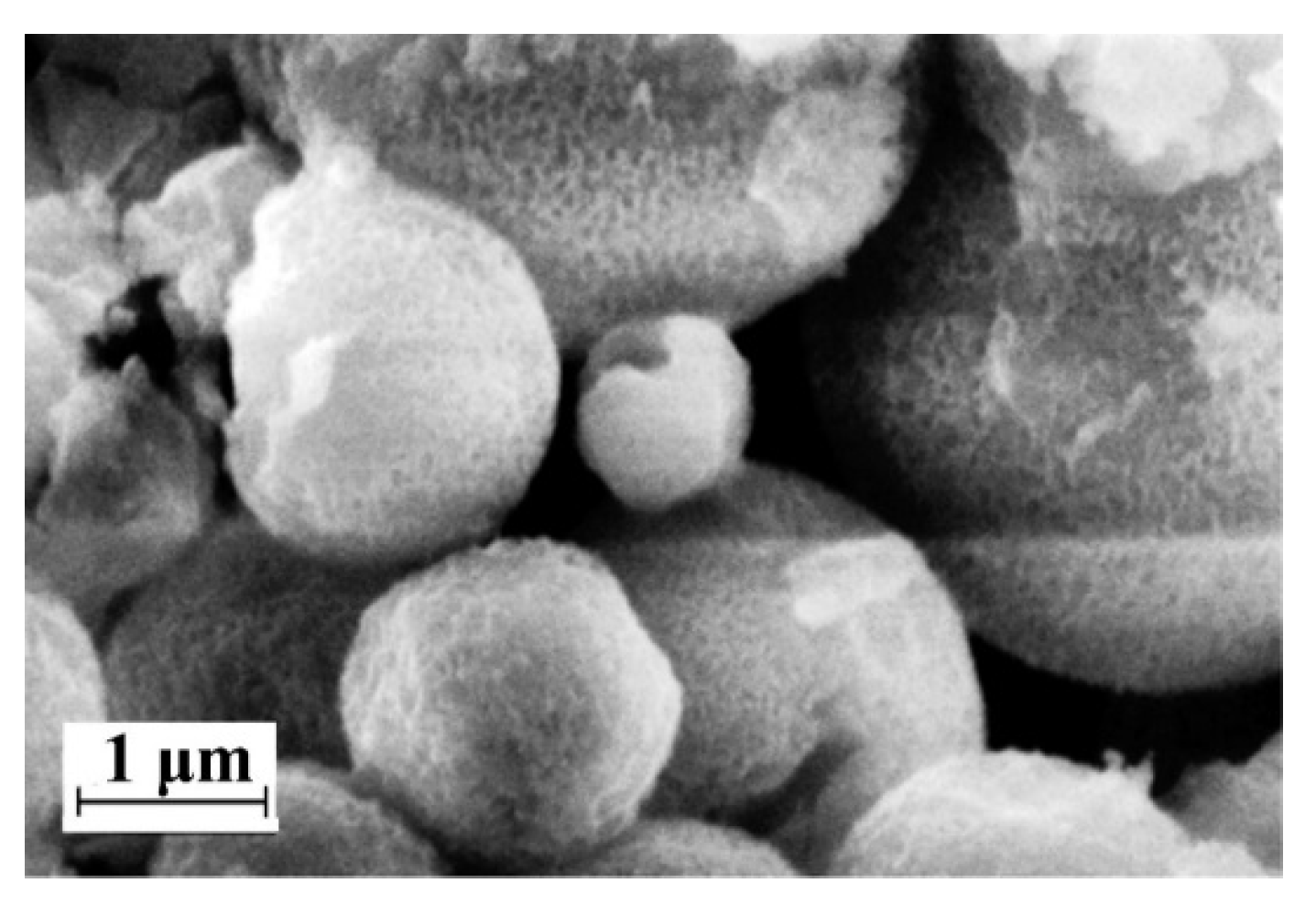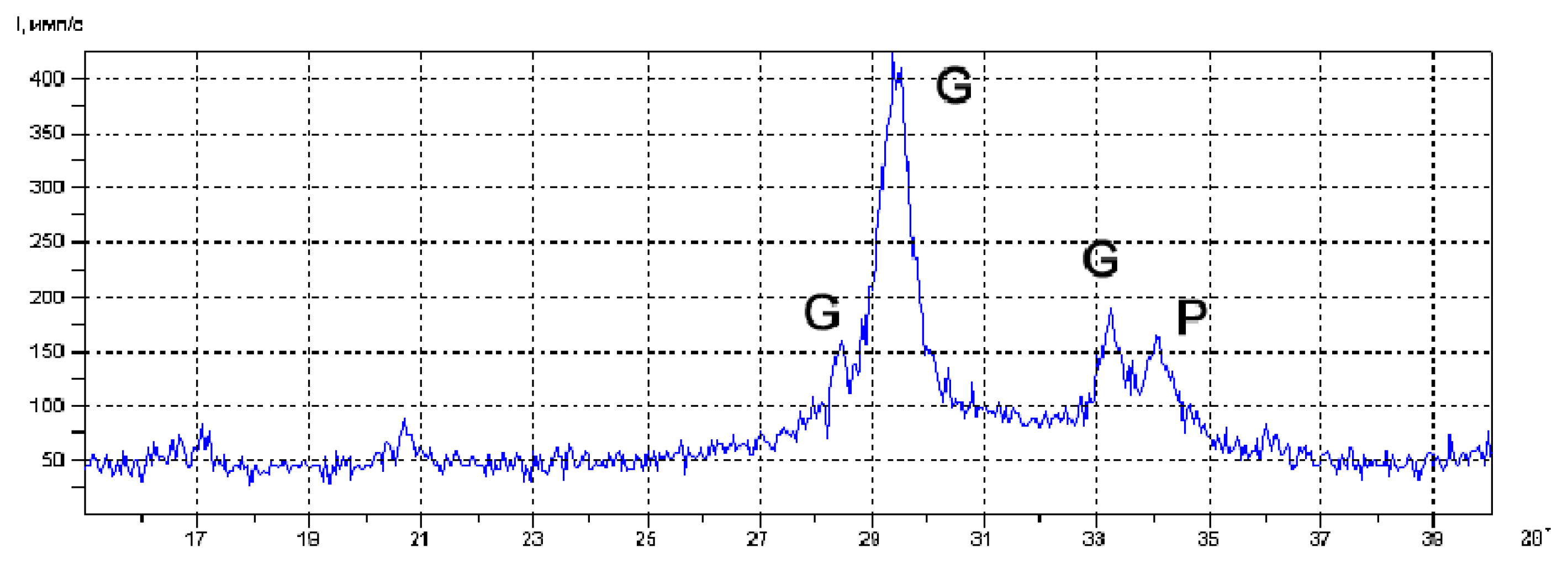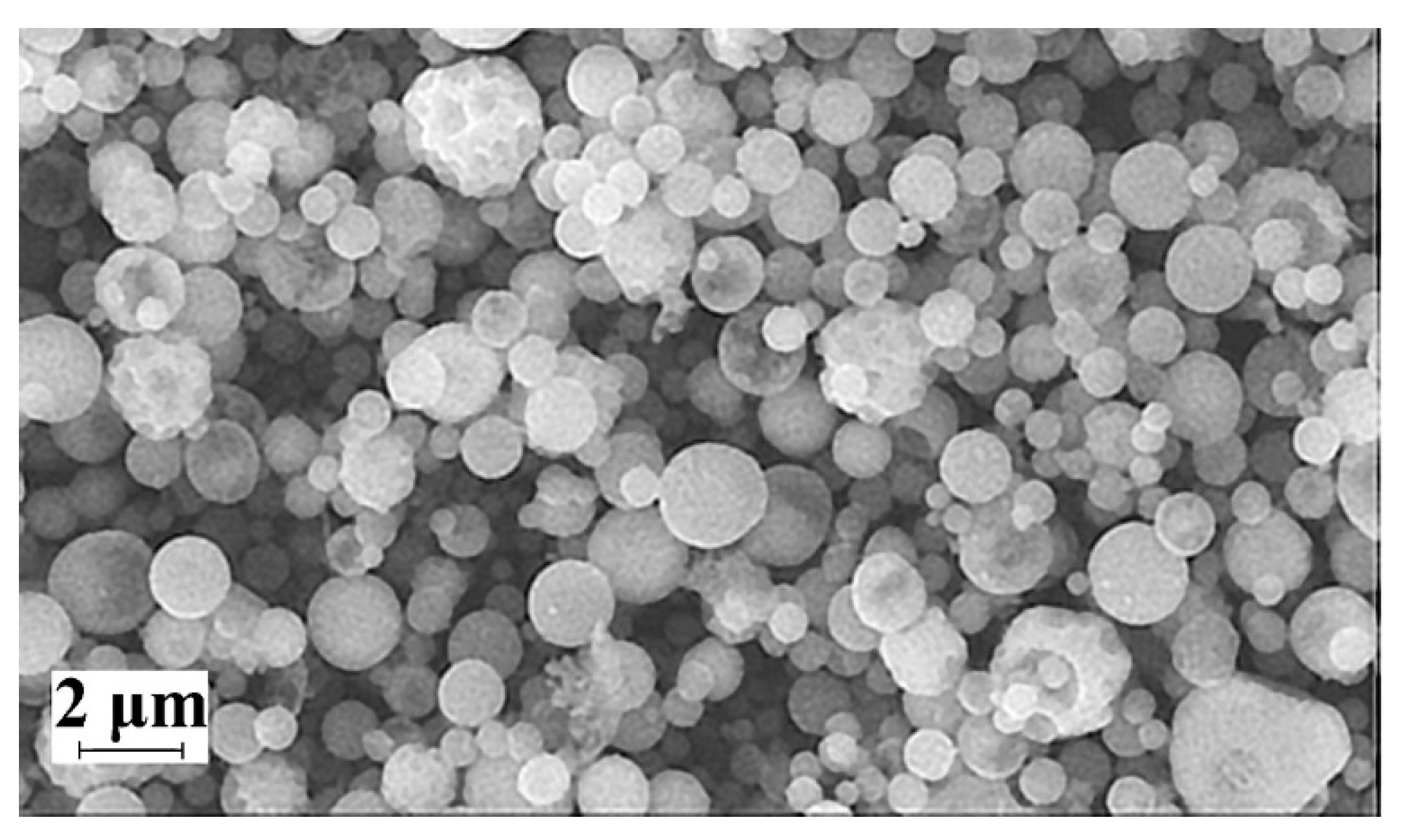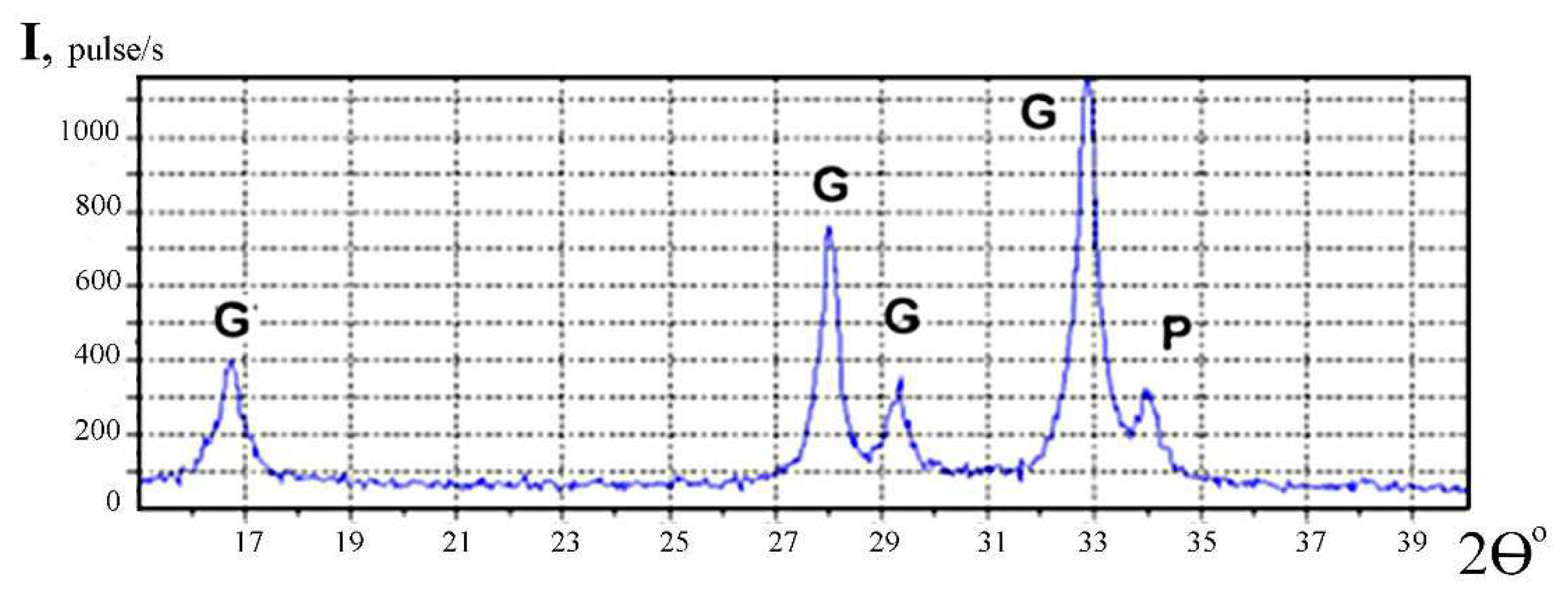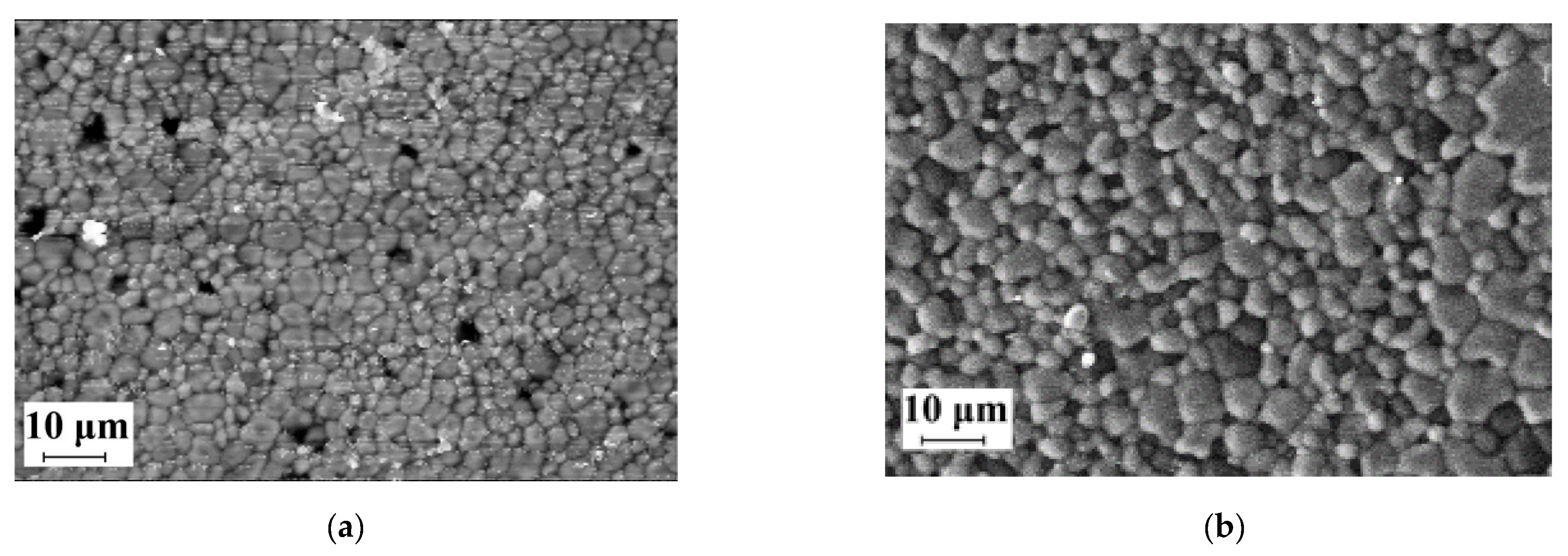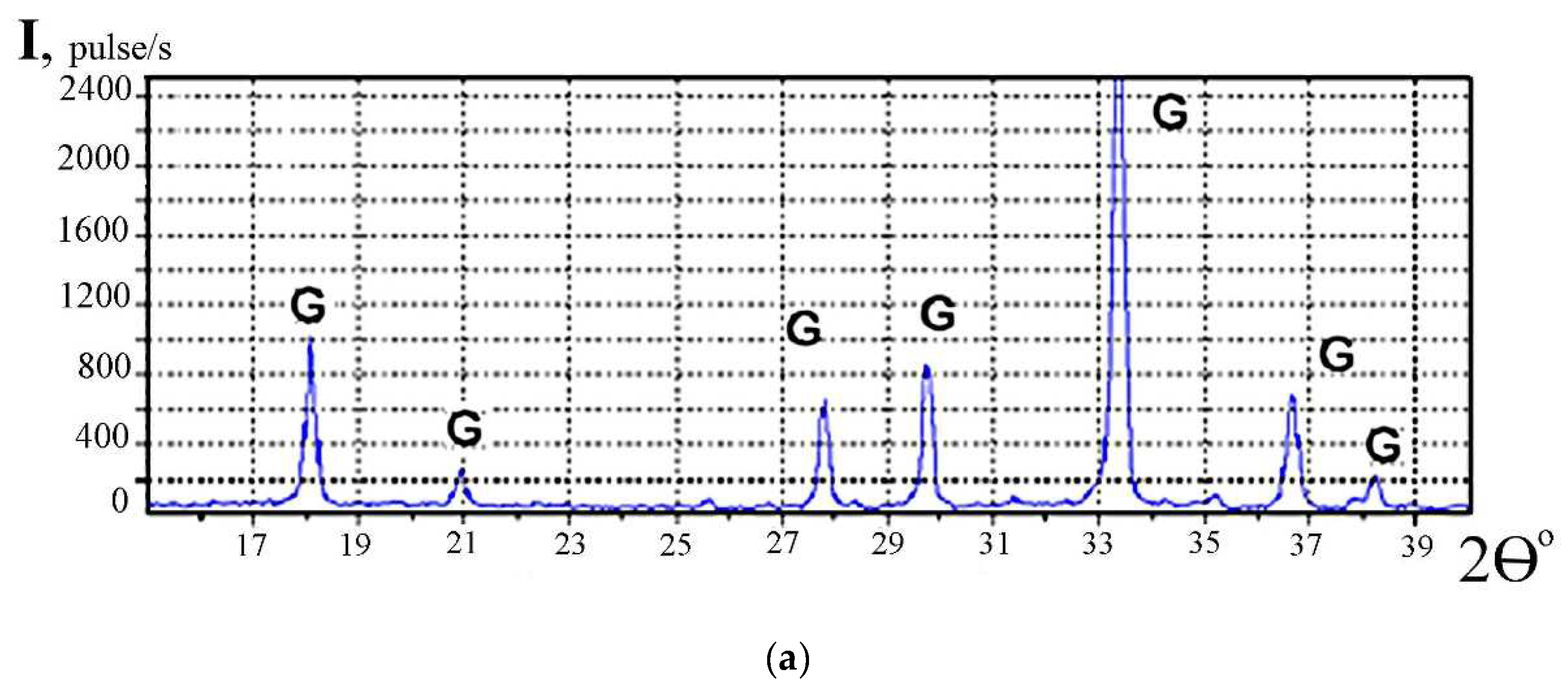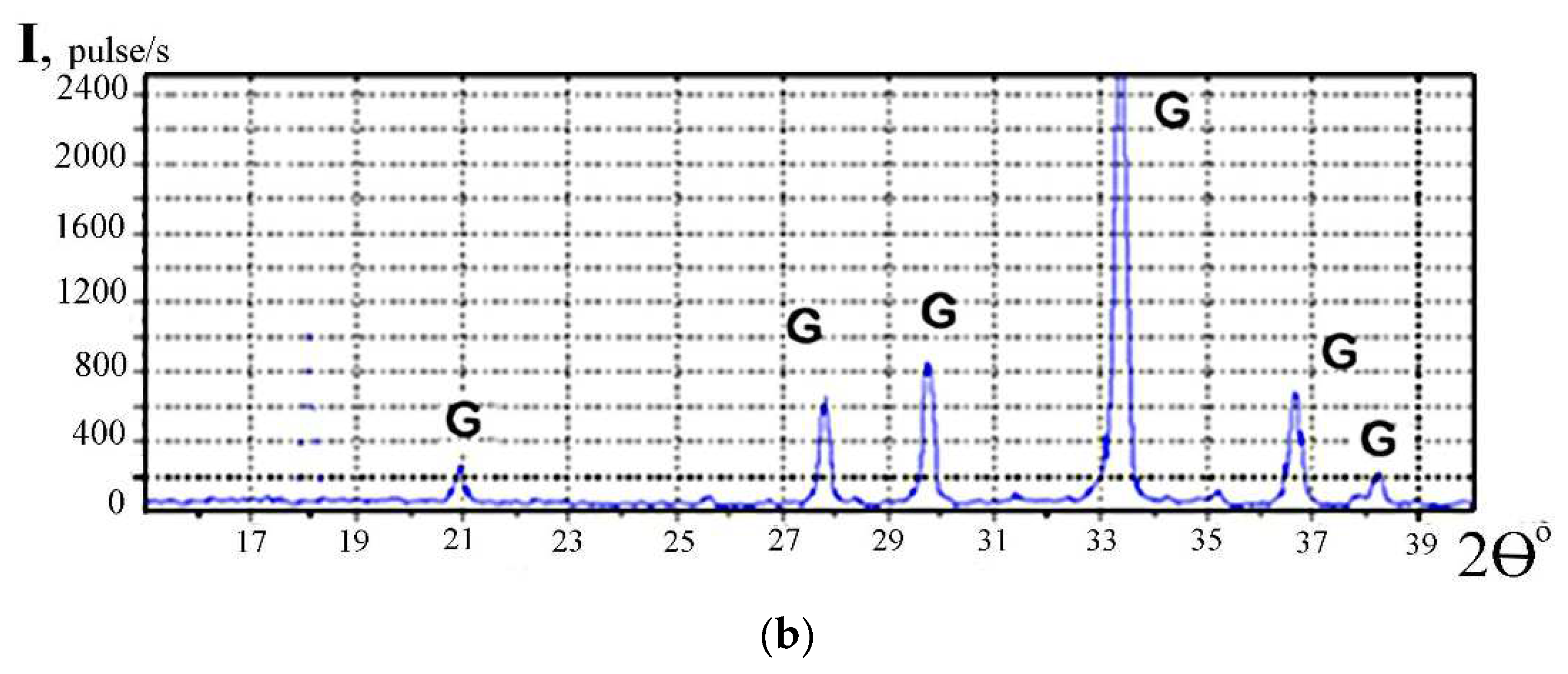1. Introduction
The widespread use of laser technologies in various fields of industry, in medicine, dentistry and in the processing of metal products, has noticeably increased the demand for high-power Solid State Lasers. However, the extended use of such lasers is hindered by the significant difficulties encountered in the fabrication of single-crystal active radiation sources of large sizes made of yttrium aluminum garnet ceramics lasers (YAG-ceramics), since the production of this material by the Czochralski Cz method takes several weeks and is carried out at a very high temperature (1970 °C). Therefore, there was a need to create new alternative materials for the active substance, the production technology of which would be simpler and less expensive.
With the development of powder technologies, YAG ceramics with a polycrystalline structure were the most suitable material for this purpose [
1,
2] An important advantage of this material is its high manufacturability, which makes it possible to manufacture active elements in a much shorter time (several hours) with lower energy costs. In addition, it is possible to produce products of an arbitrary shape at a relatively low cost using powder technology. However, despite these advantages, polycrystalline YAG ceramics, due to lower optical properties, have not yet been able to completely replace the single-crystal material. The raw material base for the manufacture of polycrystalline YAG-ceramics are ultrafine powders with a dispersion of from 30 to 300 nm. At present, the following methods for the synthesis of such powders are the most common. The method of liquid-phase co-precipitation [
3,
4,
5], in which YAG nanopowders are synthesized by precipitation in the course of chemical reactions between nitrates and precipitants (ammonium hydroxide, urea) and the sol-gel method [
6,
7,
8], which includes the preparation of a colloidal solution that turns into a gel with the formation of high-purity and chemically homogeneous materials. The first method makes it possible to obtain powders at relatively low temperatures, but encounters difficulties when the cationic ions that are used do not form precipitates. In addition, when using this method, it is difficult to control the deposition rates of cationic ions and it is also impossible to avoid the loss of cationic ions during filtration, which leads to the appearance of optically inhomogeneous regions in the final product. The second method is cheaper than the first and more efficient, since it allows for methodological problems in the production of YAG ceramics to be overcome. Despite the fact that the powders obtained using the above methods have now become commercial material, the search for other methods that can be used for the synthesis of YAG ceramic powders continues in scientific practice. One is flame spray pyrolysis (FSP). In [
9], the working solution with the required set of cations, together with the carrier gas (air) is sprayed through nozzles into the combustion zone of the methane–oxygen mixture, where the physical and chemical processes of formation of powder particles take place. A significant disadvantage of this method is a significant scatter in the size of the synthesized particles (200–1100 nm), which often contain large voids. In [
10], an aerosol based on an alcohol solution (ethanol) with a carrier gas (air) flow enters the hot zone of the reactor, where the alcohol ignites and the reaction temperature rises to 2000 °C. As a result, spherical nanosized particles with an average diameter of ≤50 nm are formed at the reactor outlet. The advantage of the FSP method is that it does not involve lengthy production steps and, compared to the co-precipitation method, provides a homogeneous mix of different starting materials at an ionic scale, and eliminates the loss of cationic ions during filtration. When implementing this method, it is necessary to use more expensive equipment. Nevertheless, FSP is a relatively fast and one-step method for obtaining nano- and micropowders in comparison with the sol-gel method mentioned above [
11].
However, all of the above methods are intended to synthesize ultrafine powders, the particles of which have a high surface activity. This positive property of nanopowders makes it possible to reduce the temperature and shorten the sintering time, reducing the cost of manufacturing the product and improving its quality. However, due to nanoparticles’ high surface activity, they spontaneously combine into strong, hard-to-destruct multi-particle agglomerates. In the powder blanks that are prepared for sintering, a highly developed local inhomogeneity of particle packing is observed, which leads to a significant decrease in the physical and mechanical properties of the compact material. Therefore, in practice, such powders are subjected to special pretreatment, which consists of a mechanical grinding of the powder in a ball mill, followed by drying in organic liquids [
12]. Such preparation includes a thorough check of the characteristics of the initial powder and requires precise control over technological parameters, which significantly increase the cost of ceramic production. In some cases, to achieve high-quality products, one has to resort to very complex molding methods, such as hot isostatic pressing (HIP) and molding in special molds under high pressure (hydrostatic, gasostatic and quasi-hydrostatic), which requires the use of complex expensive technological equipment. In addition, one of the main conditions for the manufacture of laser ceramics is the use of weakly agglomerated powders as a feedstock [
2].
Thus, there was a need to develop a method to obtain active powders that do not form strong multi-particle agglomerates. Certain prospects in this direction are opened by the ultrasonic spray pyrolysis (USP) method [
13,
14]. A schematic diagram of the process is shown in
Figure 1.
Here, as in the FSP method, a working solution containing the chemical components selected in a given proportion is converted into an aerosol using an ultrasonic generator. The size of the aerosol droplets is controlled by the viscosity of the working solution and the frequency characteristics of the generator. The carrier gas flow entrains the aerosol into a quartz reactor located inside the continuous furnace. In the reactor, under the influence of high temperature, in aerosol drops, when interacting with the reagent gas, a chemical reaction proceeds with the formation of submicron spherical powders, which are trapped at the outlet of the reactor by a collector–precipitator. This method makes it possible to synthesize submicron powders of regular spherical shape with unique physicochemical characteristics. Under certain technological conditions, the method allows for the formation of a nanofragmentary structure inside the particles [
15], which contributes to an increase in the sintering activity of relatively large powders (≈1 μm). This is explained by the specifics of the process of diffusion mass transfer occurring in a polycrystalline structure with a highly developed interface between nanosized crystals. In other words, the polycrystalline nanostructure of submicron powders increases the rate of pore healing and contributes to the achievement of a high degree of material compaction during sintering [
16]. In addition, since there is no contact between individual droplets in the aerosol during pyrolysis, sintering of the synthesized particles is excluded. Thus, under storage conditions (at room temperature), nanostructured aerosol powders do not agglomerate and, upon sintering, and upon reaching a certain temperature, they begin to show increased activity, providing a dense, non-porous structure of the ceramic material. This greatly facilitates the work with such powders.
In the present work, an attempt was made to synthesize submicron ceramic Y3Al5O12 phase powders by ultrasonic spray pyrolysis, followed by a study of their structure, and the susceptibility of the resulting aerosol powders to sintering was assessed. It should specifically be noted that the aim of the work was not to obtain powders that could impart enhanced optical and luminescent properties to the ceramic material. Therefore, the alloying elements intended for this purpose were not included in the working solution and the chemical components used were qualified as chemically pure.
2. Materials and Methods
The production of experimental powders of the Y
3Al
5O
12 phase was carried out using an experimental setup for ultrasonic spray pyrolysis assembled under laboratory conditions (
Figure 2), the principle of operation of which corresponds to the scheme shown in
Figure 1.
The basis of the equipment was a four-section continuous electric furnace (manufacturer ZAO «IETs VNIIETO») with a maximum heating temperature of up to 1100 °C, inside which a quartz tube (reactor) with an inner diameter of 30 mm was placed. The length of the active working zone, in which the temperature reaches 1100 °C, was 1 m. To generate the aerosol medium, a serial ultrasonic inhaler “Albedo” IN-72 (manufacturer LLC “Albedo”), with an operating resonant frequency of 2.6 MHz and a capacity of 4 mL/min, was used. The size of the aerosol droplets was in the range of 1–1.5 µm. The unit is also equipped with an electronic heating temperature control unit, a carrier gas feed rate control system and an electrostatic trapping system for submicron powder particles. Air was used as the carrier gas. In the preparation of working solutions, aluminum nitrate hexahydrate, Al(NO
3)
3 x 6H
2O), served as a reagent source of aluminum cations. Yttrium nitrate hexahydrate, Y(NO
3)
3 x 6H
2O, was used to obtain yttrium cations (the supplier of the reagents was OOO «Labtekh»). All reagents were qualified as “chemically pure”. Solutions were prepared on the basis of distilled water. Water was chosen as a solvent to prevent the ignition of the aerosol in the hot zone of the reactor, as was the case with an alcohol-containing solvent, in the FSP method [
10]. Structural analysis was performed on experimental samples in the form of round tablets made of synthesized powders. Semi-finished products for subsequent sintering were obtained by a uniaxial pressing of aerosol powders using an organic binder based on polyvinyl alcohol. In this case, the powders were not subjected to additional processing (mechanical grinding, granulation). Pressing was carried out on a manual laboratory hydraulic press under a pressure of 100 MPa. The sintering of the molded samples was carried out in a vacuum (vacuum 10
−2 Pa) high-temperature furnace with software control of the thermal regime. The morphology of the powder particles was studied and evaluated using images obtained with scanning electron microscope Jeol JSM-740 1F in the reflected electron mode. The average particle size was determined by laser sedimentography (Fritsch Analizette-22). X-ray phase analysis of the powders was carried out by X-ray diffractometer DRON-3 «Burevestnik». In this case, the size of nanograins inside the particles was estimated using the width of the peaks in X-ray diffraction patterns with the Scherrer method [
17].
3. Results and Discussion
The results of electron microscopy showed that the synthesized powders are mainly composed of rounded granules (
Figure 3), the average diameter of which is 1.5 μm. Moreover, on the surface of the granules, a relief of outwardly protruding nanoparticles is clearly visible. This indicates that the granules themselves are dense agglomerates formed by many nanosized particles of about 30 nm.
X-ray phase analysis showed (
Figure 4) that the formation of the required phase in particles proceeds incompletely. In addition to the Y
3Al
5O
12 phase, they contain a small percentage of the YAlO
3 phase, as well as a significant amount of the amorphous phase.
Therefore, it can be expected that the process of complete phase formation will be completed during the subsequent sintering of such powders. However, it is well known that phase transformations during powder sintering are usually accompanied by significant volumetric changes and, in most cases, these lead to a loosening of the material structure and violation of the particle-packing density. This can affect the overall density of the sintered material in the most negative way. To increase the completeness of phase formation, in our case, it was necessary to increase the temperature in the reactor core. Since the continuous electric furnace of the laboratory facility only heats the reactor core up to 1100 °C, an attempt was made to raise the reaction temperature to higher values using the heat released during the exothermic reaction [
18]. For this purpose, a small amount of (NH
2)
2CO carbonic acid diamide or urea was added to the working solution. By raising the reaction temperature in this way, it was possible to accelerate the process of phase transformations in the synthesized powders. The electron microscope image (
Figure 5) of aerosol powders obtained in this way shows significant changes in the particle morphology. Powders, for the most part, consist of particles of a regular spherical shape with an average diameter of 1.08 microns with a size spread of 60%.
Flake-like agglomerates are completely absent, and the relief of protruding nanoparticles does not appear on the surface of individual particles. This indicates the complete sintering of nanoparticles inside individual powder particles. The x-ray diffraction pattern of aerosol powders of yttrium aluminum garnet made of a working solution containing urea is shown in
Figure 6.
The peaks corresponding to the YAG phase can be seen to have become more distinct. This indicates a more complete phase transformation. However, even in this case, the heat released during the exothermic reaction turned out to be insufficient for the complete completion of the synthesis and an insignificant fraction of the YAlO3 phase is still present in the powder mass. The presence of a nanopolycrystalline structure in aerosol powders was possible to detect by analyzing the nature of the broadening of the X-ray diffraction peaks. Estimation of the grain size by the Scherer method made it possible to establish that the average size of nanocrystals is 16 nm.
In this work, the tendency of nanostructured submicron aerosol powders to sintering have been studied. For this purpose, according to the technology described above, samples were made as tablets with a diameter of 10 mm and a thickness of 2 mm, and then sintered in a vacuum high-temperature furnace. Two sintering modes were selected: 1500 °C for 3 h and 1700 °C for 6 h.
Figure 7 shows the microstructure of sintered ceramics of YAG-phase aerosol powders made from a working solution of Al(NO
3)
3 x 6H
2O + Y(NO
3)
3 x 6H
2O salts with the addition of (NH
2)
2CO.
The observed structure is characterized by a uniform distribution of equiaxed grains with a small size scatter. However, in samples sintered at a temperature of 1500 °C for 3 h, the presence of residual pores is still observed. On samples sintered at 1700 °C for 6 h, a higher-quality structure was obtained that does not contain visible pores. In this work, the density of the obtained samples was measured by hydrostatic weighing. Recalculation of the real density in % was carried out, taking the density of the crystal YAG-ρ
t = 4.55g/cm3 as the basis of reference. The density of the ceramic material measured on a sample sintered at a temperature of 1500 °C for 3 h was 97.3% of the density of the YAG crystal. The density of polycrystalline ceramics sintered at a temperature of 1700 °C for 6 h was 99.2% of the base value. X-ray phase analysis of sintered samples revealed a curious fact. The phase composition of the sintered samples is identical to the phase composition of aerosol powders made of the working solution with the addition of urea, fired at 1000 °C for 3 h (
Figure 8). In other words, the transformation of the material into the Y
3Al
5O
12 phase is fully completed during the sintering of aerosol powders in the sample. At the same time, the presence of microcracks that could arise due to volumetric changes, as mentioned above, could not be detected in the sample.

